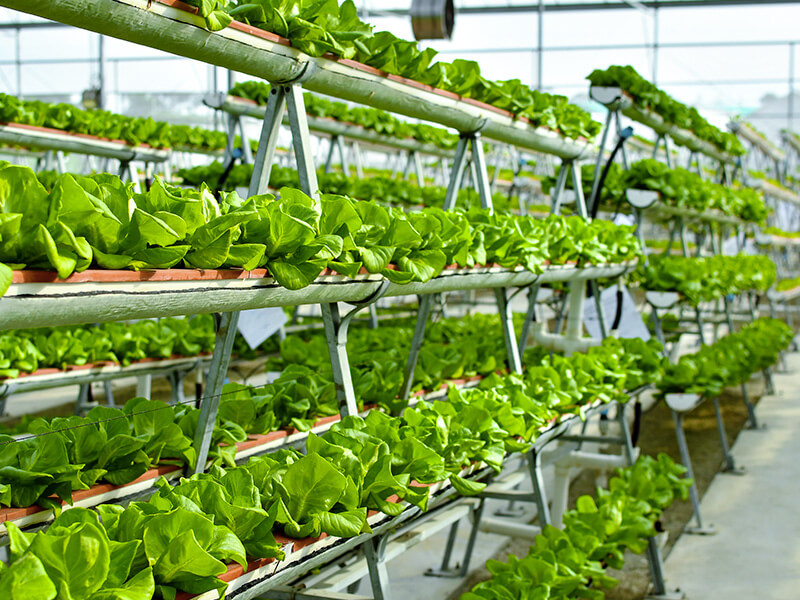What You Should Know About Vertical Farming Production


Currently, the global human population exceeds more than 7.85 billion, but this number is expected to increase to 9.8 billion by 2050— with more than 75% of people expected to be living in urban areas. Accompanied by this population growth will also be an increase in demand for already stressed food, water, and energy resources needed to sustain this growth. Thus, new agricultural systems that offer sustainable food production will be essential to meet these demands.
One such system, many believe can meet these demands, is vertical farming. But, what exactly is vertical farming and why do many people believe that? Let’s find out!
What is Vertical Farming?
Simply put, vertical farming is the practice of growing plants in vertically stacked layers. This method of horticulture seeks to maximize plant space utilization and production by scaling up off the ground, allowing more plants to be grown in the same area. Additionally, it can be applied to current horticultural practices, ranging from small-scale hydroponics to large-scale controlled environmental agriculture operations, and has the potential to produce year-round production at practically any location if coupled with the right techniques!
So, how does it work, what plants are grown, and more importantly, is it sustainable?
Basic Components of a Vertical Farm
Vertical farm types can be broken down into three main components: the (1) system structure, (2) electrical structure, and (3) plumbing structure (see figure below). These three aspects are vital to consider as they will dictate where a system can be located, what crops can be grown in them, and the resources that will be required to build one. They should be considered before starting a vertical farming operation.
Types of Vertical Farms

When it comes to vertical farming, there are three main system types: (1) hydroponic, (2) aquaponic, and (3) growing media-based systems.
Hydroponic Vertical Farming
In hydroponic vertical farming, an aqueous solution comprised of all essential nutrients needed for optimal plant growth is supplied to plants. Examples of this type of vertical farming include modified hydroponics systems, such as nutrient film technique (Ex. A-Frame and vertical grow towers), deep water culture (DWC), and aeroponics.
Aquaponic Vertical Farming
Conversely, in aquaponic vertical farming, fish production is integrated with plant production utilizing hydroponic system designs. However, instead of fertilizing plants with an aqueous solution comprised of all essential nutrients, plants are alternatively fertilized with nutrient-rich fish water that has been filtered, converted to nitrates, and supplemented to limit nutrients deficient in aquaponic systems.
Growing Media Vertical Farms
Lastly, in growing-media vertical farms, plants are cultivated in a soilless media (Ex. rock wool, coir, perlite, etc.) and then supplied with a water-nutrient solution. Examples of this system type include modified ebb and flow, wick, and raised bed systems that have been stacked on top of one another or moved into vertically designed structures.
Plant Requirements
In addition to vertical farming components and system types, it is also important to take into consideration how the plants will be grown and their requirements! For example, will they be grown outside or indoors? If they are to be grown indoors, are the proper systems in place? Is air circulation required? How does shading affect the crop quality?
In general, plants have four basic requirements to grow properly: nutrients, carbon dioxide, water, and light. Each of these factors should be addressed before upgrading a facility or opening a vertical farm.
Plant Selection
Vertical farming systems can be used to grow a wide array of plants, such as vegetables, fruits, herbs, and even flowering plants. However, before plant selection takes place, it is important to first consider the aforementioned factors to determine if it will be economically viable!
Currently, the most commonly grown commercial vertical farming crops include lettuce, microgreens, kale, basil, chives, mint, and strawberries.

Growing Media Selection for Vertical Farming
The best media to select for a vertical farming system is one that promotes good air porosity, drainage, and nutrient retention. This is necessary to ensure that plants do not stay drenched for prolonged periods, while also providing a good structure for newly developing root systems to grow in.
PRO-MIX offers several exceptional growing media products designed to establish the proper foundation essential for vertical growing. These products include PRO-MIX® BX AGTIV® REACH™, and PRO-MIX® MPO AGTIV® FORTIFY™. PRO-MIX BX is a well-balanced, general-purpose growing medium that has a blend of medium textured Sphagnum peat moss, perlite, vermiculite and a starter nutrient charge suited for large cell cultivation.
For organic growers, PRO-MIX MPO AGTIV FORTIFY is a medium textured growing medium that is OMRI-listed. Furthermore, each of these products is available with active ingredients, including Bacillus and mycorrhizae, that help to protect root systems from certain root diseases and improve nutrient uptake for enhanced plant growth.
What Are the Advantages and Disadvantages of Vertical Farming?
Finally, when it comes to growing vertical farming, this method offers a variety of benefits over other plant production practices. Such benefits associated with vertical farming include higher rates of production, improved crop quality, lower water usage, reduced fertilizer usage, reduced area required for production, and the potential for year-round production at just about any location. These systems can be quite profitable and have the potential to be part of environmental solutions if properly designed and managed.
Nonetheless, it is important to note that there are drawbacks associated with vertical farming. First, these systems can be seen as “high risk”. For example, they are very energy-intensive and require that backup systems be in place in case of power outages. Second, they require a high level of technical “know-how” to operate and can be costly to set up, monitor, and maintain. Lastly, these systems can be more susceptible to water-borne diseases or pests, which once in the system, can quickly spread from plant to plant due to the interconnectedness of these systems.
For these reasons, caution and planning is advised. In cases where growing media is used, the addition of biological additive ingredients can be beneficial to reduce the onset of plant root diseases and reduce plant loss.